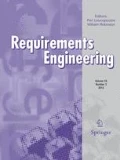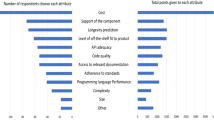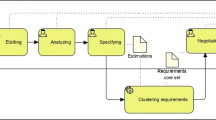Abstract
This study describes a hierarchical ranking model to help the selection of CRM (customer relationship management) packages based on their functional and technical quality. The model is tested empirically by applying the hierarchical analytical process (AHP) to a sample of 42 CRM packages. Results indicate how functionally similar packages can differ substantially in their technical quality and, thus, in their ability to be integrated within a company’s information system. The hierarchical model is verified to be dependable, since the quality-based ranking of packages is found to have a low rank-reversal probability as a consequence of managers’ uncertainty in weighing the relevance of different quality variables. From a practical standpoint, these results confirm that CRM packages differentiate in measurable quality variables, which can be used by practitioners as a framework to gather and evaluate software-selection information during feasibility analyses.


Similar content being viewed by others
References
Cahners in-stat group (2001) CRM revenues worldwide moving on up; Europe and Asia Pac to get their piece of the pie.http://www.instat.com
Desmond M (2001) CRM Software: customer service for a song. PCworld.http://www.pcworld.com
IDC (2000) Customer relationship management market forecast and analysis, 2000–2004. Report no. W22401.http://www.idc.com
IDC (2002) IDC says Asia/Pacific CRM solutions market will grow by 30%.http://www.idc.com.sg/Press/2002/AP-PR-crm.htm
King J (2001) Premier 100: CRM still in formative stages for many users. Computerwords.http://www.computerwords.com
Karlsson J, Ryan K (1997) A cost–value approach for prioritazing requirements. IEEE Softw 14(5):67–74
Sivzattian S, Nuseibeh B (2001) Calibrating value estimates of requirements. In: Third international workshop on economics-driven software engineering research. Co-located with the international conference on software engineering (ICSE)
Barua A, Ravindran S, Whinston AB (1997) Efficient selection of suppliers over the Internet. J Manag Inf Syst 13(4):117–138
Tam KY, Hui KL (2001) A choice model for selection of computer model vendors and its empirical estimation. J Manag Inf Syst 17(4):97–124
Nikoukaran J, Paul RJ (1999) Software selection for simulation in manufacturing: a review. Simulation Practice Theory 7(1):1–14
Ochs M, Pfahl D, Chrobok-Diening G, Nothhelfer-Kolb B (2001) A method for efficient measurement-based COTS assessment and selection method description and evaluation results. In: Proceedings of the seventh international software metrics symposium (METRICS 2001), pp 285−296
Dean J, Oberndolf P, Vidger M, Abts C, Erdogmus H, Maiden N, Looney M, Heneiman G, Guntersdorf M (2001) COTS workshop: confirming collaboration for successful COTS development. ACM SIGSOFT Softw Eng Notes 26(1):61–73
Choi S J, Scacchi W (2001) Modeling and simulating software acquisition process architectures. J Syst Softw 59(3):343–354
Blecherman B (1999) Adopting automated negotiation. Technol Soc 21:167–174
Boehm B, Grunbacher P, Briggs RO (2001) Developing groupware for requirements negotiation: lesson learned. IEEE Softw 18:46–55
Khirallah K (2001) CRM case study. Optimizing relationships at National Australia Bank, Ltd. TowerGroup
Compton J (2001) Case study: calling on CRM. ZdnetIndia.http://www.zdnetindia.com
Anderson EE (1990) Choice models for the evaluation and selection of software packages. J Manag Inf Syst 6(4):123–138
Maiden NA, Ncube C (1998) Acquiring COTS software selection requirements. IEEE Softw 15(2):46–56
Ahrens JD, Prywes N, Lock E (1995) Software process reengineering: toward a new generation CASE technology. Syst Softw 30:71–84
McChesney IR (1995) Towards a classification scheme for software process modeling approaches. Inf Softw Technol 37(7):363–374
Cash JI, Lawrence PR (1990) The information system research challenge: qualitative research methods. Harvard Business School Press, Cambridge
Taudes F, Mild A (2000) Options analysis of software platform decisions: a case study. MIS Q 24(2):277–243
Ossadnik W, Lange O (1999) AHP-based evaluation of AHP-software. Eur J Oper Res 118:578–588
Saaty TL (1990) How to make a decision: the analytic hierarchy process. Eur J Oper Res 48(1):9–26
Farbey B, Finkelstein A (2001) Software acquisition: a business strategy analysis. In: Proceedings of the fifth IEEE international symposium on requirements engineering, pp 76–83
Orlikowski WJ, Iacono CS (2001) Research commentary: desperately seeking the “IT” in IT research – a call to theorizing the IT artifact. Inf Syst Res 12(2):121–134
ISO/EIC 9126 (1991) Information technology – software product evaluation – quality characteristics and guidelines for their use. International standard, ISO, Genève, Switzerland
Chechik M, Gannon J (2001) Automatic analysis of consistency between requirements and designs. IEEE Trans Softw Eng 27(7):651–672
Blume M, Appel AW (1999) Hierarchical modularity. ACM Trans Program Language Syst 21(4):813–847
Greenberg P (2001) CRM at the speed of light. Osborne/McGraw-Hill
Bradshaw D, Armstrong S (2001) Ovum evaluates: eCRM. Ovum.http://www.ovum.com
Chorafas DN (2001) Integrating ERP, CRM, supply chain management and smart materials. Auerbach
Booch G (1986) Object-oriented development. IEEE Trans Softw Eng 12(2):211–221
Chau P, Tam KY (1997) Factors affecting the adoption of open systems: an exploratory study. MIS Q 21(1):1–24
Berndt DJ, Hevner AR (1997) The COR model for analyzing information systems change. In: Proceedings of the 30th Hawaii international conference on system sciences, vol 3, pp 198–207
Saaty TL (1980) The analytic hierarchy process. McGraw-Hill, New York
Keeney RL, Raiffa H (1993) Decisions with multiple objectives. Cambridge University Press
Ticehurst J (2000) CRM vendor market faces massive shakeout. In: Gartner group European symposium, Cannes
Roy B, Bouyssou D (1993) Aide Multicritère à la décision: Méthodes et Cas. Economica, Paris
Gibson J (1994) How to do system analysis. Prentice Hall, Englewood Cliffs, NJ
Mollaghasemi M, Pet-Edwards J, Gupta U (1995) A multiple criteria buy versus lease analysis for government contracts. IEEE Trans Eng Manag 42(3):278–287
Dubois D, Prade H, Testemale C (1988) Weighted fuzzy pattern matching. Fuzzy Sets Syst 28(3):313–331
Fenton NE (1996) Software metrics, a rigorous approach. Thomson Computer Press
Saaty TL, Vargas LG (1987) Uncertainty and rank order in the analytic hierarchy process. Eur J Oper Res 32:107–117
Jolliffe IT (1986) Principal component analysis. Springer, New York Berlin Heidelberg
Everitt BS, Dunn G (2001) Applied multivariate data analysis. Oxford University Press, New York
Acknowledgements
This work has been partially supported by the Italian VISPO and MAIS projects funded by the Italian Ministry of Research (MIUR). Particular thanks are expressed to Paolo Galli and Andrea Duro for their assistance in the data collection effort.
Author information
Authors and Affiliations
Corresponding author
Appendices
Appendix 1. CRM modules and sub-modules
1.1 Collaborative CRM
1.2 Analytical CRM
1.3 Operational CRM
Appendix 2. Operating definition of model variables
(Tables 19, 20, 21, 22, 23, 24, 25, 26, 27, 28, and 29)
Appendix 3. Empirical results of pair comparisons
Rights and permissions
About this article
Cite this article
Colombo, E., Francalanci, C. Selecting CRM packages based on architectural, functional, and cost requirements: Empirical validation of a hierarchical ranking model. Requirements Eng 9, 186–203 (2004). https://doi.org/10.1007/s00766-003-0184-y
Received:
Accepted:
Published:
Issue Date:
DOI: https://doi.org/10.1007/s00766-003-0184-y




